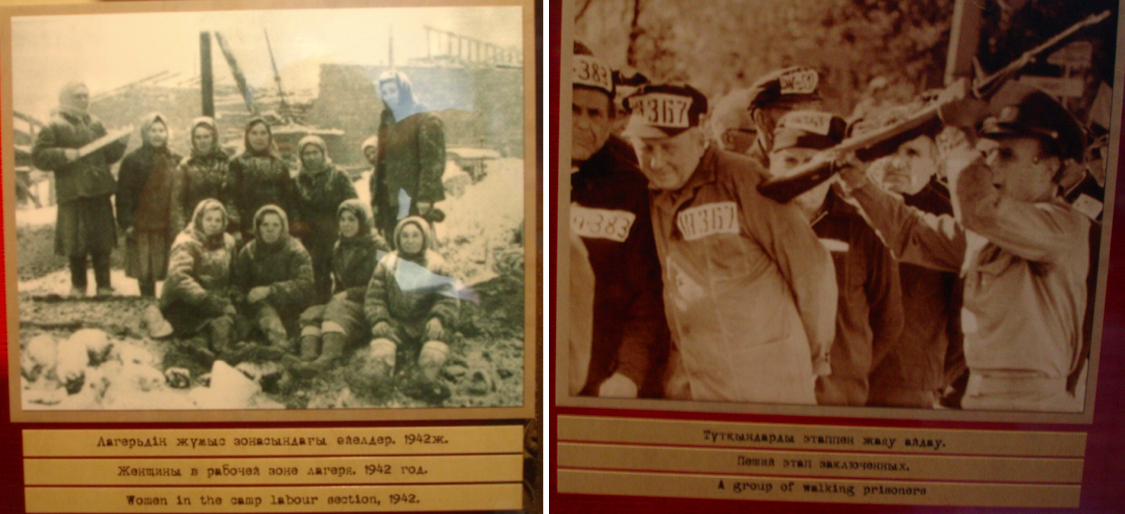104Ku - an anachronism in a gulag
Wednesday 26 June 2019
I was reading an article recently on Dark Tourism which describes a visit in 2017 to Karlag, a former Soviet gulag near Karaganda in Kazakhstan. I visited this gulag two years earlier in 2015 and the article brought back some powerful memories. It was known as the Karaganda Corrective Labour Camp (Karlag) and was opened during the Stalinist era of the Soviet union in 1931.

Political prisoners at Karlag in the 1940s
By the time it closed in 1959 more than one million political prisoners or “enemies of the people” as they were known were estimated to have passed through it. The camp covered a vast area of some 6,800 square miles (over half the size of Belgium). Many of the inmates were used as cheap agricultural labour to provide food for the developing coal mines in the Karaganda region or to work in the mines themselves. Although most of the buildings have long since disappeared, the Kazakh government maintains a museum in what was the old administrative building of the gulag at Dolinka. This details the harsh lives led by the inmates and also has many artefacts. Among the inmates were several famous scientists including Alexander Chizhevsky (1897-1964) and Nikolay Urvantsev (1893 - 1985) who conducted scientific work associated with the coal mining during their internment. There is one room which houses some of the apparatus they used and I photographed it while I was there (below).

 Hanging on the wall by the side of the apparatus was a framed Mendeleev periodic table which I also photographed (right). After reading the article I looked at my photographs again and noticed something rather odd about this periodic table. I had assumed at the time I visited that being in the museum it must have used in the gulag but now I realise that if you look closely at it you can see it contains element number 104 with the symbol Ku. Element 104 was not discovered until 1964 (some five years after the gulag closed) and there was considerably controversy over its name in what became known as the ‘transfermium wars” during the cold war period where the names of many Soviet scientists were ‘airbrushed’ out of western scientific culture. The discovery of element 104 was made at the Joint Institute of Soviet Research in Dubna in the USSR by bombarding plutonium-242 with neon-22. The Soviet scientists named it kurchatovium with the symbol Ku after Igor Kurchatov (1903-1960) who was the “father of the Soviet atomic bomb”.
Hanging on the wall by the side of the apparatus was a framed Mendeleev periodic table which I also photographed (right). After reading the article I looked at my photographs again and noticed something rather odd about this periodic table. I had assumed at the time I visited that being in the museum it must have used in the gulag but now I realise that if you look closely at it you can see it contains element number 104 with the symbol Ku. Element 104 was not discovered until 1964 (some five years after the gulag closed) and there was considerably controversy over its name in what became known as the ‘transfermium wars” during the cold war period where the names of many Soviet scientists were ‘airbrushed’ out of western scientific culture. The discovery of element 104 was made at the Joint Institute of Soviet Research in Dubna in the USSR by bombarding plutonium-242 with neon-22. The Soviet scientists named it kurchatovium with the symbol Ku after Igor Kurchatov (1903-1960) who was the “father of the Soviet atomic bomb”.Five years later in 1969 element 104 was independently synthesised in the University of California, Berkeley by bombarding californium-249 with carbon-12. The Americans claimed that they published their results first and that their work was the first to be verified independently and so claimed the right to name the element and proposed the name rutherfordium (Rf) after Ernest Rutherford (1871 – 1937). It was not until 1997 that IUPAC eventually decided to accept rutherfordium officially as the name (although they did concede the naming of element 105 to the Russians by calling it dubnium after the location of the Soviet research institute). Modern Mendeleev tables used in Russian speaking schools today do now show element 104 as rutherfordium.

A modern version of Mendeleev's periodic table used in the NIS IB school in Astana, Kazakhstan.
Clearly the Mendeleev table in the museum cannot have been in existence during the period when it was a gulag. After the last prisoners left in 1959 some of the buildings were used to house a school, hospital, and sanatorium before being allowed to fall into disrepair. It seems likely that the periodic table in the museum was used in the school during the 1970s and 80s and perhaps even much of the scientific apparatus on display could be from the school rather than from the gulag.

